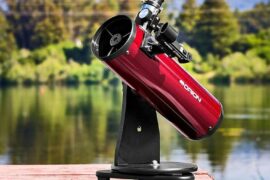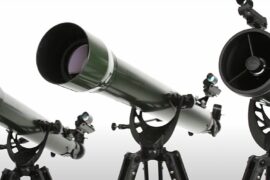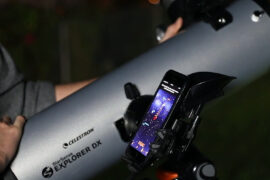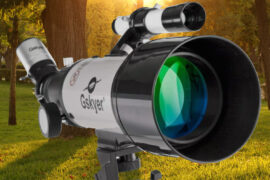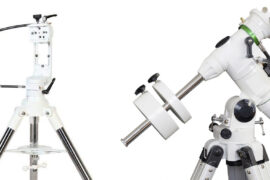Stargazing is getting more and more popular every day. As people stayed home more and more over the past few years, they started to discover this wonderful hobby they could participate in from their backyards or rooftops.
But choosing your first telescope can be intimidating. When you look at the specifications of a telescope you will see numbers and terms like aperture, focal length, magnitude, etc. Then there are the multiple types of telescopes. Refracting, reflecting, compound, and so on.
The good news is that choosing a good telescope is easier than you think, and if you are in the market looking for the best telescope under $100 dollars I have built this guide to help you navigate the sea of options out there and make an informed decision.
Buying a telescope and getting into stargazing is definitely worth it. It is an amazing, fun, and educational hobby that many of us have fallen in love with.
If you are in a hurry, here are our best picks. If you want to learn more about the selection process and more in-depth reviews for each of the items, keep reading below.
Note about the sub $100 price point in telescopes
Before you proceed, there’s something important that needs to be said for the sake of complete transparency. And it is about managing your expectations.
$100 is unfortunately not going to get you very far when it comes to getting a good telescope. While there are options in this price range, they are very limited in terms of power.
The images that a $100 device is going to get you are not going to be that great and might drive you away from the hobby as you will not be getting the full experience. If you came and asked me for my honest opinion, I would recommend you to save a little bit more and try to get something at least in the $150-$200 range.
The only cases where I would recommend getting a sub $100 telescope are the following:
- Your budget is limited and there is a deadline that will prevent you from saving more (Christmas, birthday, etc).
- As a secondary, portable telescope because you already have one that is too big to take to the field.
- As the first telescope for a kid under 10 years old.
Summary
Best telescope under $100 – Celestron TravelScope 70mm
This a very solid, portable, easy-to-use telescope with optics that challenge those of a more sophisticated device. It is an excellent option to take into the field or a learning instrument.
Best value – Orion GoScope III
Similar to the TravelScope, the GoScope offers great optics for its price and size. I would say both telescopes are very comparable, if you need to decide between them, go with the one that is on sale.
Best for kids – ACTBOT 70mm Telescope for kids
I personally tested this while making our article on the best telescopes for 5-year old kids and under and I wasn’t expecting much. I was proved wrong as this little device is well-built and offers decent optics. It is constantly on sale and comes with a lot of accessories.
Most powerful – Orion SpaceProbe II 76mm
It is almost impossible to find a telescope with an aperture larger than 70mm in this price range, and yet here it is. Unlike the other items on this list, it is a reflector, which has its pros and cons.
How to choose a telescope under $100
Out of all the technical specifications of a telescope, there are really only a couple that matter.
These are the things that you need to take into account.
Aperture
The aperture refers to the size of the main lens or mirror in a telescope. It is the most important number because it determines the maximum amount of light the device can capture. It works like a camera lens. The bigger it is, the higher the possible detail of the images you can capture.
All the telescopes in the under-$100 price point are going to be in the 50mm to 70mm range. I’d recommend going with a 70mm instrument at minimum. Less than that is going to get you too little power and not even nearby planets like Mars will look good.
The best use of your money when looking for a budget telescope is going to be looking for the largest aperture possible. The only caveat would be selecting a telescope type that fits your needs.
Telescope type
There are two main types of entry-level telescopes: refracting and reflecting scopes. We have multiple articles detailing their differences but for this price range, all that you need to know is that refracting telescopes are easier to use and don’t require any maintenance. Reflectors (also known as Newtonians) on the hand, require some maintenance and better care but offer larger apertures at low prices and fix some color errors that refractors tend to show.
For kids and teenagers, the recommendation is to go with a refractor which works very well in this price range as 99% of the models you will find are exactly that.
Focal length
The focal length of a telescope is the distance from the main lens to the exit. It is going to determine the field of view (how big the area you will see in the image is) and how “fast” the telescope is.
A larger focal length isn’t always better. In fact, to observe deep space objects, like galaxies, a short one is considered slightly better.
What to expect out of a $100 telescope
If you go with a 70mm aperture telescope as I’d recommend (less than that and you are basically buying a spyglass), here’s what you can expect to see under normal sky conditions.
- The Moon will be the best objective to watch. You can see all the major craters with good detail, and distinguish its geology.
- Mars can be observed. You might not get a great level of detail unless you have perfect sky and orbital conditions. You might be able to get a glimpse of its two Moons.
- Venus, Jupiter, and Saturn will be visible. You might be able to notice various color tones in Jupiter and with some luck see its bigger moons. Saturn’s rings can be visible but they’ll be hard to distinguish from the planet.
- Mercury, Neptune, and Uranus will be hard to see unless it is under perfect sky and orbital conditions, and even then you will most likely only see a colored dot.
- You will be able to see deep-space objects with a magnitude below 12. This means you will be able to get a good view out of some of the brighter, closer galaxies like Andromeda, the Large Magellanic Cloud, or Bode’s Galaxy.
- Some other major nebulas and star clusters will be visible.
Please note that with this list, I’m referring specifically to the devices I’m recommending below as I have tested them personally. Lower-end telescopes with smaller apertures (50mm-60mm) will get worse results.
For some photo examples, check out this article on what to expect out of a 70mm telescope. Just note that the telescopes used for that article have slightly better optics than the ones on this list.
Best telescopes under $100
Best telescope under $100 – Celestron TravelScope 70mm

A portable point-and-shoot telescope with solid optics aimed at the entry-level market,
Even when it comes to travel telescopes, 70mm (2.75″) is the minimum recommended aperture even for a beginner telescope. And that is exactly what the Celestron TravelScope offers at a reasonable cost.
Celestron is the most popular manufacturer in the market and with good reason. Their products are well made and you know exactly what you are going to get. Good optics, well-manufactured mirrors and lenses, and sturdy build quality. And that goes across all their product lines, including entry-level products like this one.
The TravelScope, as its name implies is mainly designed as a compact device that you can take with you on a camping trip or to the field for a night of stargazing. It is great for that because while it is limited in terms of power, once you take it to the field where there’s less light pollution, it will look just as good as a more expensive telescope in the city.
While this is definitely an entry-level telescope, it is a high-quality one. The images it resolves are sharp and high-contrast although it suffers a bit when it comes to brightness. Experienced eyes will be able to detect some chromatic errors and bending around the edges but that is true of every refractor telescope and as a beginner you will not notice it as you won’t know what you are looking for. If you want to learn more about that check out our article on the pros and cons of refractor telescopes.
As for accessories, it comes with a red dot finder, an erect image diagonal, two Kellner eyepieces (20mm and 10mm), and its own carry bag. If you want to compliment the included eyepieces, get a cheap 2x Barlow lens like this one that will double the number of magnifications you can play with. Read this if don’t know what a Barlow lens is.
In conclusion, the TravelScope 70mm is a good device for a kid that is asking for their first telescope or as a secondary portable scope.
Best value – Orion GoScope III

Excellent optics for its size, really good performance at a very reasonable price
Orion is another excellent brand in the optics market. The GoScope III has the exact same specifications as the Celestron TravelScope above and the quality of both is comparable.
They are so similar that it is hard to say anything about the GoScope III that isn’t already said about the TravelScope above except that maybe this one has slightly worse optics but by a very thin margin.
If I had to choose between them, I’d go with the one that is cheaper at that moment.
The only minor difference between them is that this comes with a 9mm eyepiece instead of the 10mm one of the TravelScope. The 9mm one is going to result in slightly higher magnification (for eyepieces, the shorter the focal length the more magnification you get) but the difference is minimal.
I put this in the best value category because of two reasons.
First: it is on sale more often than not.
And second, it is also available as a kit that includes a moon filter and is still within budget. Since the moon is going to be one of your main objectives with this telescope, it can come in handy (see: do you need a moon filter?).
Best for kids – ACTBOT 70mm Telescope for Kids
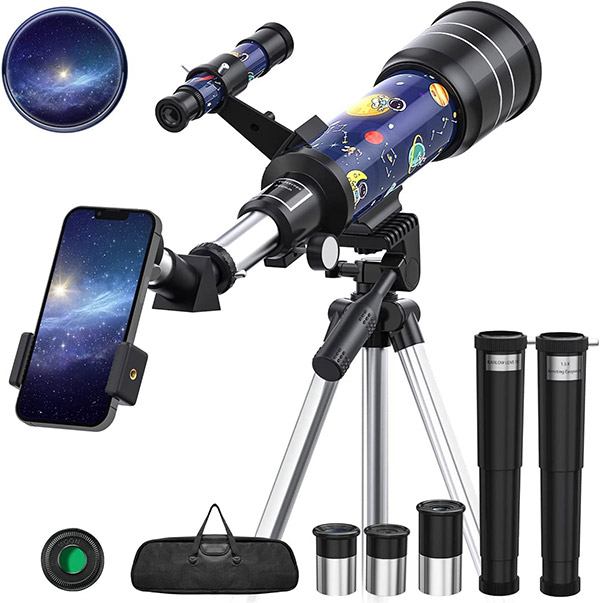
Excellent value with lots of included accessories and designed specifically for kids.
The ACTBOT 70mm was a bit of a surprise when I tried it as I wasn’t really expecting much from it. It looks more like a toy than a telescope with all the stickers around its body. And yet, it held its own and turned out to have very decent optics for its very low price.
It has a 70mm aperture lens and it is very compact with just 360mm of focal length. That not only makes it ultra-portable, but it makes it easy for kids to carry it and set up without help.
The tripod could definitely be better but it is good enough and has the right size to be comfortable for children.
The best thing about the ACTBOT is all the accessories it comes with. It includes three eyepieces (6mm, 12mm, 20mm), a finder scope, moon filter, carry bag, and even a smartphone adapter. But the most curious thing it comes with are two extra-long Barlow lenses (3x and 1.5x). These Barlows, unlike regular ones, are made so the telescope can be used comfortably at a longer distance. All these accessories really add to the price-to-value ratio of this telescope as it is not common for a device to include all that.
While the ACTBOT is not even close to being a powerful telescope, it is very well designed thinking about the best features for a kid’s telescope. It also has excellent value thanks to all the accessories it comes with. It makes for a great Christmas or birthday present.
Most powerful – Orion SpaceProbe II
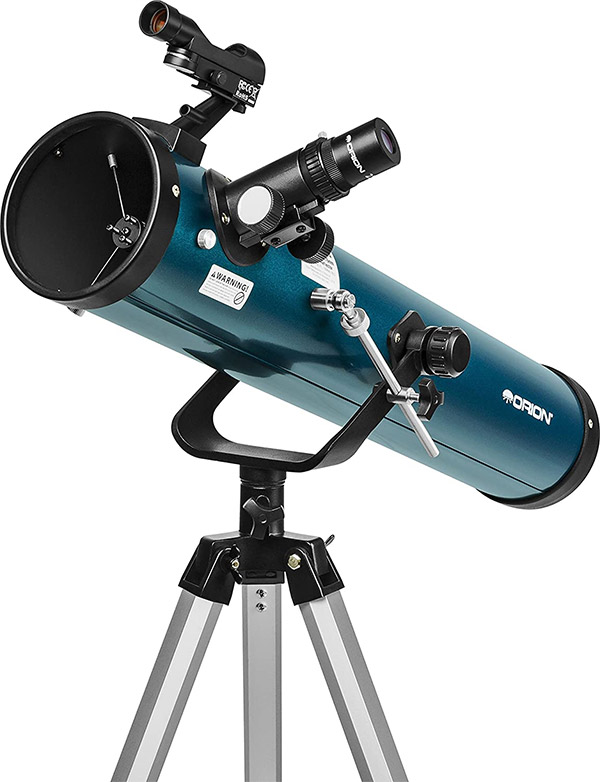
Largest telescope and one of the only few Newtonian telescopes that you will find in this price range.
It is very uncommon to find Newtonian telescopes below 114mm of aperture. So the 76mm model of the Orion SpaceProbe is a very curious experiment.
Being a Newtonian telescope not only gives the SpaceProbe a small advantage in size which results in more detailed images, but it also fixes the color and spherical errors that refracting telescopes tend to show.
Not everything is good news though. Newtonian telescopes need occasional maintenance in the form of collimation, which means the main mirror needs to be re-aligned every few months or it will start to show ghost images. Collimating a mirror is not too difficult and only takes 15-30 minutes but if you are thinking for example of gifting this to a kid, they’ll require help and supervision to do it. The building process the first time you open it is also a bit more complicated.
The quality of the Orion SpaceProbe is great. You can definitely tell the difference in detail between it and the 70mm refractors above even though the size difference is not that significant.
As for accessories, it comes with a red dot finder and two Kellner eyepieces (25mm and 10mm).
While the SpaceProbe II is a high-quality telescope that fits the budget if you are really set on not going above it, for full disclosure I believe it is important to note that you can get a much larger 114mm device for not much more than that. A good example would be the ESSLNB 114mm.
Related reading
Enjoyed this article?
Get daily 10-minute PDFs about astronomy to read before bed!
Sign up for our upcoming micro-learning service where you will learn something new about space and beyond every day while winding down.


